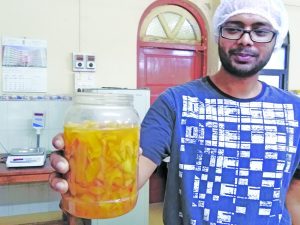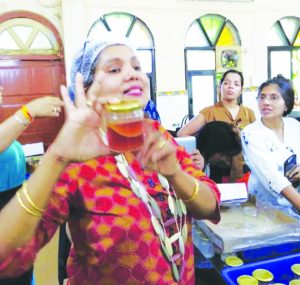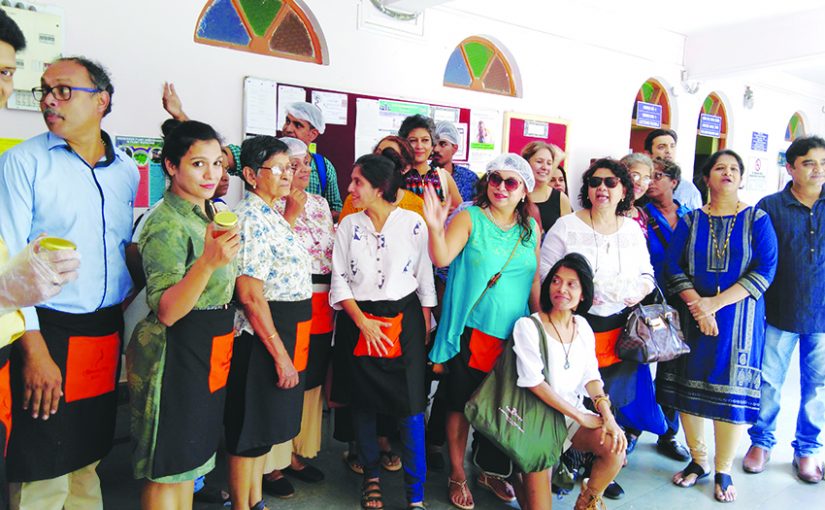GETTING HEALTHY TOGETHER: (above) All for a healthier world, a group photo; (inset) Varsha Naik
BY TARA NARAYAN
Eating is Fun / Eating is Yuck! – A variety food column
HEALTH consciousness is speeding up in Goa, hurrah! I am so glad that both the GCCI Women’s Wing and Goa College of Home Science are promoting and spreading the good word about how to drink, eat and live to be happy…most of us are unhappy although we pretend otherwise. Could be because we think wealth is health and not health is wealth!
The definition of a good life is changing rapidly now. Life is no longer about boozing all kinds of industrial beverages, eating industrial foods to the gills so that we totter to bed past midnight and …er…pop pills to sleep the sleep of the dead rather than the sleep of the alive and kicking.
Being alive and kicking has become my favourite all-time phrase these days. When I heard that Varsha Naik, Christabel Shrivastva and Arina Frank (all women with substance and style in Goa) were putting together a workshop to introduce participants to some of the world’s favourite probiotics for a healthier gut, I thought this I must see and on a Saturday (Nov 17, my birthday) trotted off to treat myself to the mysteries of fermented live food or probiotics as they are called: Kombuchea, kefir, apple cider vinegar.

These three probiotics are super foods along with yogurt, German sauerkraut, Oriental tempeh, Korean kimchi and many more, wonder if one may add Goan chepnim mango and some of our pickles to this list? There are probiotics in most of our traditional cuisines, basically meaning fermented foods.
THE story is we are eating so much industrialized food nowadays that the human gut is in a mess. Herein lies the root of our modern-day lifestyle illnesses/diseases. If you’re asking me the industrial food revolution is the worst thing to have happened to Mother Earth and all life on earth including us. Humankind is enemy No.1! The message going out loud and clear is to return to feeling, thinking, drinking, eating in all the right ways — never mind that most of us are lost in a maze of confused messages on this subject.
Well, one part of it is to begin by restoring our degenerated gut by introducing it to friendly bacteria found in fermented foods or probiotics. Ask Varsha Naik (assistant professor, Goa College of Home Science) and she will convince you when it comes to disease we must first look into the micro flora or microorganisms in our body. They reside all over and especially in the gut where we have no idea what a battle royal goes on — between the good guys and bad guys, that is the bacteria we host. If bad wins over good in our gut all the time our entire digestive system is on the rocks…
So we look at prebiotics and probiotics for damage control. Probiotics are fermented foods with good bacteria to improve the quality of our microbiome (gut to you and me). Not for nothing is the gut often described as the second brain of the body… even if both are constantly at war to keep us alive and kicking or speed us into what my hubby at least calls the departure lounge of life!
Varsha is a clinical nutritionist, activist par excellence and works overtime to improve the eating habits of children and adults. If anyone knows the latest on the subject of keeping body beautiful ticking and kicking I’d say it is Varsha Naik, and her two friends Arina Frank (environmental sciences, microbiology, a hands on teacher par excellence at St Xavier’s College in Mapusa) and Christabel Shrivastava of Carasid who has an extremely health-conscious son (Siddharth) and I hear hubby Sam’s favourite pass-time is to run away to participate in every marathon!
THE “workshop for a healthier you” was a learning experience for maybe 25 to 30 participants out in classroom and lab of the Goa College of Home Science (off Campal promenade in Panaji). It was all the talk of kombuchea, apple cider and kefir which drew us all there. Health conscious folk these days begin their day with a tablespoon of apple cider vinegar in warm water (stir in a teaspoon of honey if you wish to make it more palatable)…or drink or serve kombuchea (or kombucha tea) to family and friends…or, how about a bowlful of kefir laced with wild honey?
It’s confirmed now that fermented foods help restore good bacteria in the gut, improve gut micro flora (also called microbiota). Hey, bacteria outnumber cells 10 to one in body beautiful! If you’re in trouble with your stomach (the most acidic place in the body) you may want to add probiotic/prebiotic food in your eating habits.
Also distinguish between prebiotics and probiotics. Prebiotics are fertilizer helping good bacteria to do their job better, fibre-rich foods like onions, leeks, garlic, apples, flaxseeds, barley, oats, etc. When it comes to prebiotics, thick fibre food makes for a healthier gut and colon, improves metabolic health, boosts immunity. From the sound of it prebiotics and probiotics work in tandem for superior health.
If Varsha clued us up about the impact of diet on gut micro flora, Arina took us out to the lab and taught us how to make

friends with kombuchea, apple cider vinegar and kefir…some of the world’s famous probiotics. Arina has an earnest, entertaining spirit and showed everybody how to keep the three probiotic foods alive and kicking in the kitchen and fridge and her enthusiasm was contagious!
Kombuchea or kombucha is this mushroom-styled soft jello “animal” which breeds in its own juices created out of green tea and bit sugar. A culture of bacteria and yeast called scoby is used as a starter to arrive at fermented kombucha tea. Interestingly, kombuchea breeds like crazy and one may drain off the liquid to keep drinking the fermented juice or beverage. It’s sweetish-tartish, depending on age.
Breeding kombuchea at home must be a bit like taking care of a pet at home! It takes a while to get the hang of it and patience is essential, handle gently with clean hands at all times and use glassware to breed kombuchea. Give away all the baby kombuchea to whoever you wish for recycling. Kombucha tea or beverage is less than 0.5% alcoholic and has small amounts of caffeine. Some call it kombucha beer.
THEN Arina handed out gloves to get busy chopping the best Indian apples to make apple cider vinegar. It’s quite an elaborate process but considering how all the fancy apple cider vinegar available in the market place are so expensive…it’s worth making one’s own at home. I must confess I haven’t succeeded with either kombuchea or apple cider vinegar but have taken to making kefir happily. Workshop over we all got starter samples for making apple cider vinegar, kombuchea and kefir…and these days I’m making my own kefir at home.
Kefir is the easiest to do and really nothing much to it. Basically kefir is fermented animal milk curd native to Eastern Europe/South West Asia …comes to us from the Turkish “keyif” meaning feeling good or be happy after eating it, or something like that. Compare it to our home-made milk dahi or yogurt which is lactobacillus rich; but kefir I learn is better with something like 12 live bacteria having a synergetic dance, it’s also protein, calcium, vitamin D rich.
Ever since I’ve taken to making kefir at home I can’t make up my mind what I love more! My homemade cow’s milk dahi or my home-made cow’s milk kefir…this is to say I’m happy with my bowl of homemade dahi laced with honey, and happier with my home-made kefir laced with honey. Kefir can be more deliciously tart and has a slightly different flavour.
This is to say I had a great birthday! Thank you for the workshop Varsha, Arina and Christabel …more such workshops for a healthier us please. I add here that if you’re constantly plagued by stomach problems, suffer from irritable bowel syndrome (to which cancer is linked later on) do check out probiotics/prebiotics. Add them to your daily eating habits and see what a difference for the better it can make. Study the difference over say a month to three months at least and share the results with me so that I may share them here. Keep watching this space!
Organic Apple Cider Vinegar from Mother of Vinegar Starter
Ingredients:
Clean and dry ceramic or glass jar (preferably with a wide mouth like pickle jar)
Organic apples and apple skins – enough to fill the jar ¾ of the ay full
2 tbsps sugar
2 cups filtered water
Mother of Vinegar culture
Pebble for weight
Cheesecloth
Rubber band
Procedure:
Wash and peel the apples. If using skins make sure they don’t have the waxy coat. Chop and keep the cut apples aside and let them rest at room temperature. Wait till they turn slightly brown, fill the jar to ¾ the capacity.
Dissolve the sugar in the water, add the mother of vinegar and pour over the apples making sure they are submerged.
Use a clean pebble or small glass jar (thoroughly clean on the outside) to weigh down and prevent apple exposure to air.
Cover the jar with a cheesecloth and rubber band.
Store in a cool dark place for three weeks. Fermentation process depends on season — less during summer, bit longer during colder months.
After three weeks, strain out the apple cider pieces and return the liquid to the same jar.
Stir with a plastic or wooden spoon every few days.
When it reaches the desired tartness, (in another two-three weeks) strain into another bottle and use.
Keep the residual liquid and the floating mother in the jar to start a new batch of fermentation.
Tips:
Use clean and sterile equipment. (Pour in boiling water and drain dry or keep cleaned jar in hot sun).
Different types of apples — granny smiths, golden delicious, red delicious, Fiji etc can be used. Over-ripe, partly damaged apples can be used after removing the blackened damaged parts.
White scum on the top and bubbling is normal. Keep apples submerged under the water. This will help prevent mold.
Scum of any other colour (green, blue, grey, black) is not good hence discard.
Make sure the jar is well covered to avoid flies.
Do not use a solid lid to facilitate breathing.
